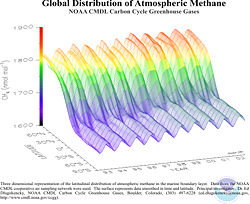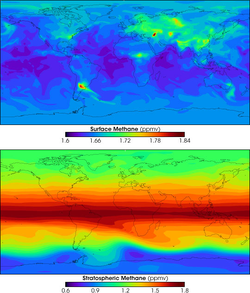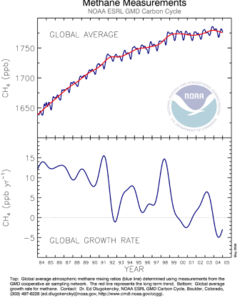Methane
2008/9 Schools Wikipedia Selection. Related subjects: Chemical compounds
| Methane | |
|---|---|
 |
|
| Other names | Marsh gas, firedamp |
| Identifiers | |
| CAS number | [74-82-8] |
| SMILES | C |
| InChI | 1/CH4/h1H4 |
| Properties | |
| Molecular formula | CH4 |
| Molar mass | 16.0425 g/mol |
| Appearance | Colorless gas |
| Density | 0.717 kg/m3, gas |
| Melting point |
-182.5 °C, 91 K, -297 °F |
| Boiling point |
-161.6 °C, 112 K, -259 °F |
| Solubility in water | 3.5 mg/100 mL (17 °C) |
| Hazards | |
| MSDS | External MSDS |
| Main hazards | Highly flammable (F+) |
| NFPA 704 | |
| R-phrases | R12 |
| S-phrases | (S2), S9, S16, S33 |
| Flash point | -188 °C |
| Related compounds | |
| Related Alkanes | Ethane, propane |
| Related compounds | Methanol, chloromethane, formic acid, formaldehyde, silane |
| Supplementary data page | |
| Structure and properties |
n, εr, etc. |
| Thermodynamic data |
Phase behaviour Solid, liquid, gas |
| Spectral data | UV, IR, NMR, MS |
| Except where noted otherwise, data are given for materials in their standard state (at 25 °C, 100 kPa) Infobox disclaimer and references |
|
Methane is a chemical compound with the molecular formula CH4. It is the simplest alkane, and the principal component of natural gas. Methane's bond angles are 109.5 degrees. Burning one molecule of methane in the presence of oxygen releases one molecule of CO2 (carbon dioxide) and two molecules of H2O:
- CH4 + 2O2 → CO2 + 2H2O
Methane's relative abundance and clean burning process makes it a very attractive fuel. However, because it is a gas (at normal temperature and pressure; see STP), methane is difficult to transport from its source. In its natural gas form, it is generally transported in bulk by pipe or LNG carriers; few countries still transport it by truck. One of these countries is the USA.
Methane is a relatively potent greenhouse gas with a high global warming potential of 72 (averaged over 20 years) or 25 (averaged over 100 years) . Methane in the atmosphere is eventually oxidized, producing carbon dioxide and water. As a result, methane in the atmosphere has a half life of seven years (every seven years, the amount of methane halves).
The abundance of methane in the Earth's atmosphere in 1998 was 1745 parts per billion, up from 700 ppb in 1750. In the same time period, CO2 increased from 278 to 365 parts per million. The radiative forcing effect due to this increase in methane abundance is about one-third of that of the CO2 increase . In addition, there is a large, but unknown, amount of methane in methane clathrates in the ocean floors. Global warming could release this methane, which could cause a further sharp rise in global temperatures. Such releases of methane may have been a major factor in previous major extinction events. The Earth's crust also contains huge amounts of methane. Large amounts of methane are produced anaerobically by methanogenesis. Other sources include mud volcanoes which are connected with deep geological faults.
Properties
Methane is the major component of natural gas, about 97% by volume. At room temperature and standard pressure, methane is a colorless, odorless gas; the smell characteristic of natural gas is an artificial safety measure caused by the addition of an odorant, often methanethiol or ethanethiol. Methane has a boiling point of −161 ° C at a pressure of one atmosphere. As a gas it is flammable only over a narrow range of concentrations (5–15%) in air. Liquid methane does not burn unless subjected to high pressure (normally 4–5 atmospheres.)
Potential health effects
Methane is not toxic; however, it is highly flammable and may form explosive mixtures with air. Methane is violently reactive with oxidizers, halogens, and some halogen-containing compounds. Methane is also an asphyxiant and may displace oxygen in an enclosed space. Asphyxia may result if the oxygen concentration is reduced to below 19.5% by displacement. The concentrations at which flammable or explosive mixtures form are much lower than the concentration at which asphyxiation risk is significant. When structures are built on or near landfills, methane off-gas can penetrate the buildings' interiors and expose occupants to significant levels of methane. Some buildings have specially engineered recovery systems below their basements to actively capture such fugitive off-gas and vent it away from the building. An example of this type of system is in the Dakin Building, Brisbane, California.
Reactions of methane
Main reactions with methane are: combustion, steam reforming to syngas, and halogenation. In general, methane reactions are hard to control. Partial oxidation to methanol, for example, is difficult to achieve; the reaction typically progresses all the way to carbon dioxide and water.
Combustion
In the combustion of methane, several steps are involved:
Methane is believed to form a formaldehyde (HCHO or H2CO). The formaldehyde gives a formyl radical (HCO), which then forms carbon monoxide (CO). The process is called oxidative pyrolysis:
- CH4 + O2 → CO + H2 + H2O
Following oxidative pyrolysis, the H2 oxidizes, forming H2O, replenishing the active species, and releasing heat. This occurs very quickly, usually in significantly less than a millisecond.
- 2H2 + O2 →2H2O
Finally, the CO oxidizes, forming CO2 and releasing more heat. This process is generally slower than the other chemical steps, and typically requires a few to several milliseconds to occur.
- 2CO + O2 →2CO2
Hydrogen activation
The strength of the carbon-hydrogen covalent bond in methane is among the strongest in all hydrocarbons, and thus its use as a chemical feedstock is limited. Despite the high activation barrier for breaking the C–H bond, CH4 is still the principal starting material for manufacture of hydrogen in steam reforming. The search for catalysts which can facilitate C–H bond activation in methane and other low alkanes is an area of research with considerable industrial significance.
Reactions with halogens
Methane reacts with all halogens given appropriate conditions, as follows:
- CH4 + X2 → CH3X + HX
where X is a halogen: fluorine (F), chlorine (Cl), bromine (Br), or iodine (I). This mechanism for this process is called free radical halogenation.
Uses
Fuel
Methane is important for electrical generation by burning it as a fuel in a gas turbine or steam boiler. Compared to other hydrocarbon fuels, burning methane produces less carbon dioxide for each unit of heat released. Also, methane's heat of combustion is about 802 kJ/mol, which is lower than any other hydrocarbon, but if a ratio is made with the molecular mass (16.0 g/mol) divided by the heat of combustion (902 kJ/mol) it is found that methane, being the simplest hydrocarbon, actually produces the most heat per unit mass than other complex hydrocarbons. In many cities, methane is piped into homes for domestic heating and cooking purposes. In this context it is usually known as natural gas, and is considered to have an energy content of 39 megajoules per cubic meter, or 1,000 BTU per standard cubic foot.
Methane in the form of compressed natural gas is used as a fuel for vehicles, and is claimed to be more environmentally friendly than alternatives such as gasoline/petrol and diesel. Research is being conducted by NASA on methane's potential as a rocket fuel. One advantage of methane is that it is abundant in many parts of the solar system and it could potentially be harvested in situ, providing fuel for a return journey.
Industrial uses
Methane is used in industrial chemical processes and may be transported as a refrigerated liquid (liquefied natural gas, or LNG). While leaks from a refrigerated liquid container are initially heavier than air due to the increased density of the cold gas, the gas at ambient temperature is lighter than air. Gas pipelines distribute large amounts of natural gas, of which methane is the principal component.
In the chemical industry, methane is the feedstock of choice for the production of hydrogen, methanol, acetic acid, and acetic anhydride. When used to produce any of these chemicals, methane is first converted to synthesis gas, a mixture of carbon monoxide and hydrogen, by steam reforming. In this process, methane and steam react on a nickel catalyst at high temperatures (700–1100 °C).
- CH4 + H2O → CO + 3H2
The ratio of carbon monoxide to hydrogen in synthesis gas can then be adjusted via the water gas shift reaction to the appropriate value for the intended purpose.
- CO + H2O → CO2 + H2
Less significant methane-derived chemicals include acetylene, prepared by passing methane through an electric arc, and the chloromethanes ( chloromethane, dichloromethane, chloroform, and carbon tetrachloride), produced by reacting methane with chlorine gas. However, the use of these chemicals is declining, acetylene as it is replaced by less costly substitutes, and the chloromethanes due to health and environmental concerns.
Methane in Earth's atmosphere
Early in the Earth's history—about 3.5 billion years ago—there was 1,000 times as much methane in the atmosphere as there is now. The earliest methane was released into the atmosphere by volcanic activity. During this time, Earth's earliest life appeared. These first, ancient bacteria added to the methane concentration by converting hydrogen and carbon dioxide into methane and water. Oxygen did not become a major part of the atmosphere until photosynthetic organisms evolved later in Earth's history. With no oxygen, methane stayed in the atmosphere longer and at higher concentrations than it does today.
In present times, due to the increase in oxygen, the amount of methane has decreased. The average mole concentration of methane at the Earth's surface in 1998 was 1,745 ppb. Its concentration is higher in the northern hemisphere as most sources (both natural and human) are larger. The concentrations vary seasonally with a minimum in the late summer mainly due to removal by the hydroxyl radical.
Methane is created near the surface, and it is carried into the stratosphere by rising air in the tropics. Uncontrolled build-up of methane in Earth's atmosphere is naturally checked—although human influence can upset this natural regulation—by methane's reaction with hydroxyl radicals formed from singlet oxygen atoms and with water vapor.
Methane as a greenhouse gas
Methane in the Earth's atmosphere is an important greenhouse gas with a global warming potential of 25 over a 100-year period. This means that a methane emission will have 25 times the impact on temperature of a carbon dioxide emission of the same mass over the following 100 years. Methane has a large effect for a brief period (about 10 years), whereas carbon dioxide has a small effect for a long period (over 100 years). Because of this difference in effect and time period, the global warming potential of methane over a 20 year time period is 72. The Earth's methane concentration has increased by about 150% since 1750, and it accounts for 20% of the total radiative forcing from all of the long-lived and globally mixed greenhouse gases.
Emissions of methane
Houweling et al. (1999) give the following values for methane emissions (Tg/a=teragrams per year):
| Origin | CH4 Emission | ||
|---|---|---|---|
| Mass (Tg/ a) | Type (%/a) | Total (%/a) | |
| Natural Emissions | |||
| Wetlands (incl. Rice agriculture) | 225 | 83 | 37 |
| Termites | 20 | 7 | 3 |
| Ocean | 15 | 6 | 3 |
| Hydrates | 10 | 4 | 2 |
| Natural Total | 270 | 100 | 45 |
| Anthropogenic Emissions | |||
| Energy | 110 | 33 | 18 |
| Landfills | 40 | 12 | 7 |
| Ruminants (Livestock) | 115 | 35 | 19 |
| Waste treatment | 25 | 8 | 4 |
| Biomass burning | 40 | 12 | 7 |
| Anthropogenic Total | 330 | 100 | 55 |
| Sinks | |||
| Soils | -30 | -5 | -5 |
| Tropospheric OH | -510 | -88 | -85 |
| Stratospheric loss | -40 | -7 | -7 |
| Sink Total | -580 | -100 | -97 |
| Emissions + Sinks | |||
| Imbalance (trend) | +20 | ~2.78 Tg/ppb | +7.19 ppb/a |
Slightly over half of the total emission is due to human activity.
Living plants (e.g. forests) have recently been identified as a potentially important source of methane. A 2006 paper calculated emissions of 62–236 Tg a-1, and "this newly identified source may have important implications". However the authors stress "our findings are preliminary with regard to the methane emission strength". These findings have been called into question in a 2007 paper which found "there is no evidence for substantial aerobic methane emission by terrestrial plants, maximally 0.3% of the previously published values".
Long term atmospheric measurements of methane by NOAA show that the build up of methane has slowed dramatically over the last decade, after nearly tripling since pre-industrial times . It is thought that this reduction is due to reduced industrial emissions and drought in wetland areas.
Removal processes
The major removal mechanism of methane from the atmosphere involves radical chemistry ; it reacts with the hydroxyl radical (·OH), initially formed from water vapor broken down by oxygen atoms that come from the cleavage of ozone by ultraviolet radiation:
- CH4 + ·OH → ·CH3 + H2O
This reaction in the troposphere gives a methane lifetime of 9.6 years. Two more minor sinks are soil sinks (160 year lifetime) and stratospheric loss by reaction with ·OH, ·Cl and ·O1D in the stratosphere (120 year lifetime), giving a net lifetime of 8.4 years. Oxidation of methane is the main source of water vapor in the upper stratosphere (beginning at pressure levels around 10 kPa).
Sudden release from methane clathrates
At high pressures, such as are found on the bottom of the ocean, methane forms a solid clathrate with water, known as methane hydrate. An unknown, but possibly very large quantity of methane is trapped in this form in ocean sediments. The sudden release of large volumes of methane from such sediments into the atmosphere has been suggested as a possible cause for rapid global warming events in the Earth's distant past, such as the Paleocene–Eocene Thermal Maximum of 55 million years ago.
One source estimates the size of the methane hydrate deposits of the oceans at ten trillion tons (10 exagrams). Theories suggest that should global warming cause them to heat up sufficiently, all of this methane could again be suddenly released into the atmosphere. Since methane is twenty-three times stronger (for a given weight, averaged over 100 years) than CO2 as a greenhouse gas; this would immensely magnify the greenhouse effect, heating Earth to unprecedented levels (see Clathrate gun hypothesis).
Release of methane from bogs
Although less dramatic than release from clathrates, but already happening, is an increase in the release of methane from bogs as permafrost melts. Although records of permafrost are limited, recent years (1999 to 2007) have seen record thawing of permafrost in Alaska and Siberia.
Recent measurements in Siberia show that the methane released is five times greater than previously estimated .
Extraterrestrial methane
Methane has been detected or is believed to exist in several locations of the solar system. It is believed to have been created by abiotic processes, with the possible exception of Mars.
- Mars
- Jupiter
- Saturn
- Iapetus
- Titan — (There seem to be hydrocarbon lakes around the polar regions)
- Enceladus
- Uranus
- Ariel
- Miranda
- Oberon
- Titania
- Umbriel
- Neptune
- Triton
- Pluto
- Charon*
- Eris
- Comet Halley
- Comet Hyakutake
Traces of methane gas are present in the thin atmosphere of the Earth's Moon.
Methane has also been detected in interstellar clouds.
- Methane is believed to be present on Charon, but it is not 100% confirmed.
Methane has also been detected on the extrasolar planet HD 189733b. This is the first detection of an organic compound on planets outside the solar system. It is unknown how it originated, when the high temperature (700°C) favors the formation of carbon monoxide instead.





